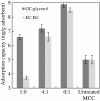Glycerol carbonate as green solvent for pretreatment of sugarcane bagasse
- PMID: 24156757
- PMCID: PMC4015548
- DOI: 10.1186/1754-6834-6-153
Glycerol carbonate as green solvent for pretreatment of sugarcane bagasse
Abstract
Background: Pretreatment of lignocellulosic biomass is a prerequisite for effective saccharification to produce fermentable sugars. In this study, "green" solvent systems based on acidified mixtures of glycerol carbonate (GC) and glycerol were used to treat sugarcane bagasse and the roles of each solvent in deconstructing biomass were determined.
Results: Pretreatment of sugarcane bagasse at 90°C for only 30 min with acidified GC produced a solid residue having a glucan digestibility of 90% and a glucose yield of 80%, which were significantly higher than a glucan digestibility of 16% and a glucose yield of 15% obtained for bagasse pretreated with acidified ethylene carbonate (EC). Biomass compositional analyses showed that GC pretreatment removed more lignin than EC pretreatment (84% vs 54%). Scanning electron microscopy (SEM) showed that fluffy and size-reduced fibres were produced from GC pretreatment whereas EC pretreatment produced compact particles of reduced size. The maximal glucan digestibility and glucose yield of GC/glycerol systems were about 7% lower than those of EC/ethylene glycol (EG) systems. Replacing up to 50 wt% of GC with glycerol did not negatively affect glucan digestibility and glucose yield. The results from pretreatment of microcrystalline cellulose (MCC) showed that (1) pretreatment with acidified alkylene glycol (AG) alone increased enzymatic digestibility compared to pretreatments with acidified alkylene carbonate (AC) alone and acidified mixtures of AC and AG, (2) pretreatment with acidified GC alone slightly increased, but with acidified EC alone significantly decreased, enzymatic digestibility compared to untreated MCC, and (3) there was a good positive linear correlation of enzymatic digestibility of treated and untreated MCC samples with congo red (CR) adsorption capacity.
Conclusions: Acidified GC alone was a more effective solvent for pretreatment of sugarcane bagasse than acidified EC alone. The higher glucose yield obtained with GC-pretreated bagasse is possibly due to the presence of one hydroxyl group in the GC molecular structure, resulting in more significant biomass delignification and defibrillation, though both solvent pretreatments reduced bagasse particles to a similar extent. The maximum glucan digestibility of GC/glycerol systems was less than that of EC/EG systems, which is likely attributed to glycerol being less effective than EG in biomass delignification and defibrillation. Acidified AC/AG solvent systems were more effective for pretreatment of lignin-containing biomass than MCC.
Figures
Similar articles
-
Effects of glycerol on enzymatic hydrolysis and ethanol production using sugarcane bagasse pretreated by acidified glycerol solution.Bioresour Technol. 2015 Sep;192:367-73. doi: 10.1016/j.biortech.2015.05.093. Epub 2015 Jun 2. Bioresour Technol. 2015. PMID: 26056778
-
Laboratory and pilot scale pretreatment of sugarcane bagasse by acidified aqueous glycerol solutions.Bioresour Technol. 2013 Jun;138:14-21. doi: 10.1016/j.biortech.2013.03.065. Epub 2013 Mar 28. Bioresour Technol. 2013. PMID: 23612157
-
Evaluation of lime and hydrothermal pretreatments for efficient enzymatic hydrolysis of raw sugarcane bagasse.Biotechnol Biofuels. 2015 Dec 2;8:205. doi: 10.1186/s13068-015-0384-y. eCollection 2015. Biotechnol Biofuels. 2015. PMID: 26633992 Free PMC article.
-
Comparison of Corn Stover Pretreatments with Lewis Acid Catalyzed Choline Chloride, Glycerol and Choline Chloride-Glycerol Deep Eutectic Solvent.Polymers (Basel). 2021 Apr 6;13(7):1170. doi: 10.3390/polym13071170. Polymers (Basel). 2021. PMID: 33917314 Free PMC article.
-
Cellulosic and hemicellulosic fractions of sugarcane bagasse: Potential, challenges and future perspective.Int J Biol Macromol. 2021 Feb 1;169:564-582. doi: 10.1016/j.ijbiomac.2020.12.175. Epub 2020 Dec 29. Int J Biol Macromol. 2021. PMID: 33385447 Review.
Cited by
-
A snapshot of microbial diversity and function in an undisturbed sugarcane bagasse pile.BMC Biotechnol. 2020 Feb 28;20(1):12. doi: 10.1186/s12896-020-00609-y. BMC Biotechnol. 2020. PMID: 32111201 Free PMC article.
-
Glycerol Carbonate as an Emulsifier for Light Crude Oil: Synthesis, Characterization, and Stability Analysis.Molecules. 2024 Oct 18;29(20):4937. doi: 10.3390/molecules29204937. Molecules. 2024. PMID: 39459305 Free PMC article.
-
Computational inference of the structure and regulation of the lignin pathway in Panicum virgatum.Biotechnol Biofuels. 2015 Sep 17;8:151. doi: 10.1186/s13068-015-0334-8. eCollection 2015. Biotechnol Biofuels. 2015. PMID: 26388938 Free PMC article.
-
Silver(I)-Promoted Cascade Reaction of Propargylic Alcohols, Carbon Dioxide, and Vicinal Diols: Thermodynamically Favorable Route to Cyclic Carbonates.ACS Omega. 2017 Jan 31;2(1):337-345. doi: 10.1021/acsomega.6b00407. eCollection 2017 Jan 31. ACS Omega. 2017. PMID: 31457234 Free PMC article.
-
First Stage of the Development of an Eco-Friendly Detergent Formulation for Efficient Removal of Carbonized Soil.Molecules. 2022 Nov 2;27(21):7460. doi: 10.3390/molecules27217460. Molecules. 2022. PMID: 36364294 Free PMC article.
References
-
- Iranmahboob J, Nadim F, Monemi S. Optimizing acid-hydrolysis: a critical step for production of ethanol from mixed wood chips. Biomass Bioenerg. 2002;6:401–404. doi: 10.1016/S0961-9534(02)00016-8. - DOI
LinkOut - more resources
Full Text Sources
Other Literature Sources
Miscellaneous





